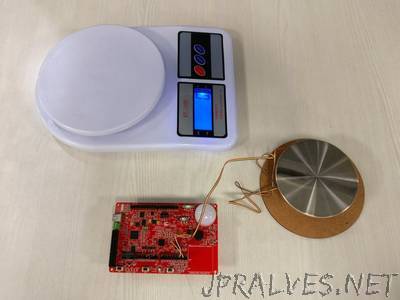
“This project describes the making of a simple weighing scale using the Cypress PSoC Analog Coprocessor and a weight/load sensor (also known as a load cell or strain gauge). A Load cell is a transducer which converts the applied force into change in resistance. The fundamental principle behind the working is the Poisson effect. The application of force on a material in one direction, leads to a deformation in the perpendicular direction. Resistances of the load cell are arranged in the form of a Wheatstone bridge. The goal is to measure this change in resistance and translate it back into the units of force (or weight). For this project, the load cell used is a TE FX1901-0001-0025L with the full scale input force of 25 lbf (11.34 kg) and the output voltage span of 20mV/V. This means that if we power the load cell with a voltage (a.k.a “excitation voltage”) of 5.0V (typical PSoC VDD), the output span would be 100mV. The TE load cell encompasses a circuit similar to the Wheatstone bridge with one of the arms being the strain gauge which is sensitive to force. The load cell exposes two terminals at which the excitation voltage is to be provided, and two other terminals for the output. The differential voltage across the output is sensed using an analog front end (AFE) implemented in the PSoC Analog Coprocessor. The sensed values are translated into the corresponding mass and made accessible through an I2C interface. The project is implemented on a PSoC Analog Coprocessor kit (CY8CKIT-048) which can be connected to the PC and the output can be visualized on Bridge Control Panel software (the related configuration files LoadCell_BCP.iic and LoadCell_BCP.ini are attached). The red LED on the kit is also made to glow proportional to the sensed load.”
